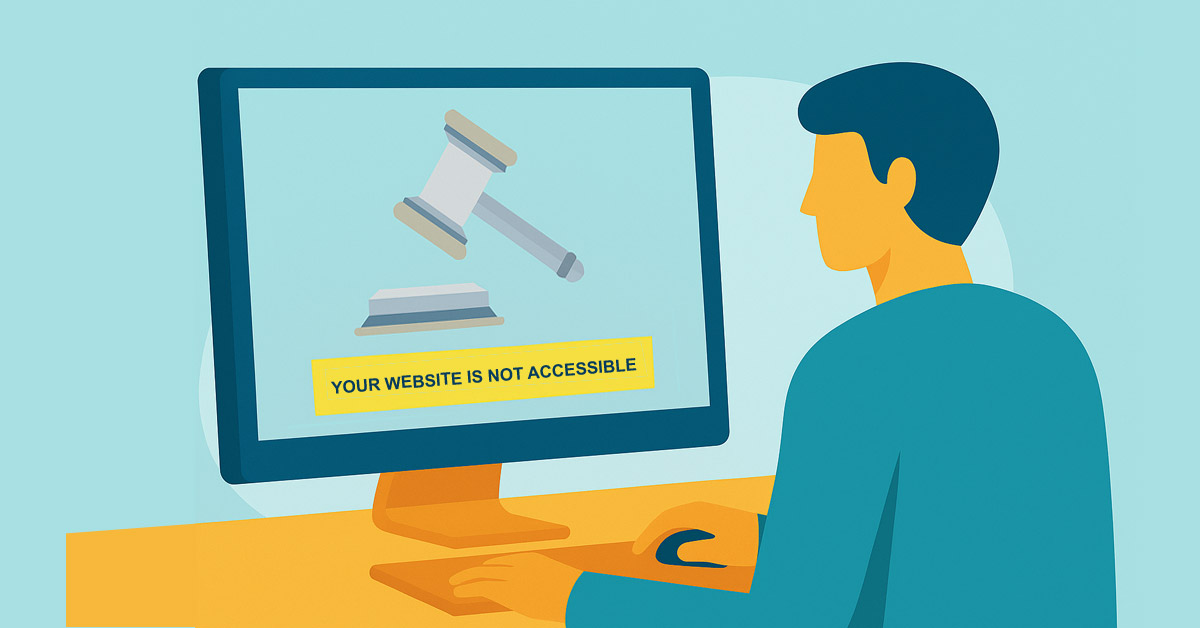Barnes & Noble. Fox News. Domino’s Pizza. Beyonce Knowles. What do these seemingly disparate but well-known brands have in common? They’ve all been sued for ADA violations for websites that were not usable to people with disabilities.
Under Title III of the Americans with Disabilities Act (ADA), businesses and facilities open to the public must provide accessibility for people with disabilities. The U.S. Department of Justice and numerous courts have extended this requirement to include websites, not just physical locations. Failure to meet these standards can result in accessibility lawsuits. For brick-and-mortar buildings this means wheelchair ramps and Braille signs, but what does it mean for websites?
Determining Website Accessibility
When you think about a legally blind visitor entering a courthouse, you think about how they might navigate the space using the tools at hand. They could be finding their way using a white cane and tactile floor guides. For navigating websites, these same individuals could use screen readers and refreshable Braille displays. There are also screen magnifiers, adaptive keyboards, and captioning services.
If your website doesn’t allow these tools to properly access your website’s functionality, it’s in violation and could mean accessibility lawsuits.
What Makes a Website Accessible
Tools like screen readers browse a webpage differently from the way humans do. Rather than seeing what’s presented on the screen, they scan the code behind the webpage and present the content it thinks is relevant. When it’s just text, there’s usually no problem. But a website typically includes images, buttons, and dynamic content (content that doesn’t appear until the user makes an action.)
Keyboard Navigation
Using a mouse requires one to be able to see where to point and click. Alternatively, if you hit the Tab key on a keyboard, the focus of the website automatically advances to the next clickable object on the page, and hitting the Enter key will “click” it. A properly accessible webpage will have a tab order that makes sense, going through each link, navigation item, and button in the order it is displayed. Sometimes dynamic content will cause that tab order to jump around, or be skipped entirely.
Image ALT Tags
A screen reader can’t interpret an image because all it sees is the code behind it. The HTML tag for images have an “alt” attribute that allows you to specify what the image is or says. This is of particular importance for banners or other images that contain text. If you have a fancy banner image that says “Serving Southern California” but no alt text, the screen reader is unable to convey that information. Adding “Serving Southern California” into the alt attribute allows the screen reader to “see” it and convey it to the user.
Clear Link Purpose
When a user is tabbing through available links, a screen reader will read the link text aloud (or produce Braille) as it focuses on it. I’ve seen countless websites that look like: To learn more about this product, click here. It makes sense to a person reading the entire sentence, but to a screen reader that is jumping through available links, all the user will understand is “click here”.
The link text (the clickable part of the text) needs to be meaningful. A better way to format this sentence and link is: Learn more about this product. The screen reader can now convey the purpose of the link.
Links also need to be obvious, either by an underline or a contrasting color. If a user can’t tell that a portion of text is clickable, it’s not compliant. These are only a few (very few!) requirement for web accessibility. A more complete outline would require an entire manual. This is why web accessibility is a specialty field with its own certifications.
Recent Trends
Certain industries appear to be more impacted by ADA lawsuits than others. In 2023, 10 industries accounted for over 90% of lawsuits filed. These industries are:
| Fashion & Lifestyle |
| Restaurant, Food & Beverage |
| Medical & Health |
| Furniture & Home Decor |
| Beauty & Body Care |
| Toys, Gifts, and Flowers |
| Travel & Hospitality |
| Retail & Consumer Goods |
| Home Garden & Outdoor Recreation |
| Education & Magazines |
If your business is in one of these industries, it’s worth your time to ensure your website is accessible sooner rather than later. Not only will you be protecting your business from litigation, you’ll also be embracing a wider audience.
How to Avoid Accessibility Lawsuits
Use Reliable, Well-Tested Platforms
There are numerous choices when it comes to building your website. To help you choose which is best for you, I’ve evaluated some of the most well-known content management systems for accessibility. There is no “best for everyone” solution, but there will likely be one that is best-suited to your situation.
Conduct an Accessibility Audit
You can do this yourself if you know what to look for. Using a Voluntary Product Accessibility Template (VPAT) can serve as an outline. To fill out this form requires an understanding of the Web Content Accessibility Guidelines (WCAG). I must warn you though, it’s a lot. This is why the vast majority of business owners hire a web accessibility specialist to conduct this audit.
Train Your Content Creators
Even after your website has been audited and all accessibility issues fixed, new issues could be introduced when new content is created. For example, if a page displays tabular data with color-coded rows, and those colors means something, that meaning needs to also be conveyed in a way that a blind or color-blind user can understand. I wrote a guide with pointers for content creators.
Have an Accessibility Statement
Most businesses have a mission statement, but accessibility statements are not so common. This statement should outline your commitment to accessibility, specify the web standards you follow (like WCAG), and describe your ongoing efforts to meet these standards. Federal websites have a set of criteria their statements needs to include, but privately-owned websites don’t have such rigorous requirements. There are some general recommendations though. Check out my guide on how to write your own accessibility statement.
Does it feel too intimidating? If you hire a web accessibility specialist to audit and/or fix your website, you can also have that person write it for you.
When your website is accessible, that’s one less thing to worry about. No business owner wants accessibility lawsuits. And the added bonus is a much improved user experience that strengthens your brand’s reputation for inclusivity.

